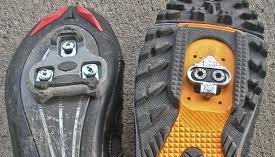

If any question ever comes up when I mention that I’m a PT that does a lot of bike fitting, the topic of shoe/cleat interface always seems to come up. For some reason, there exists this sense of voodoo black magic when it comes to shoe and cleat fitting. Why is this? Perhaps the bike industry is to blame, which constantly bombards us with new models of shoes, cleats, wedges, inserts, adjustability, style, cleat rotation, medial/lateral placement, the amount of ‘float’, and so on. I guess making it really hard for the average rider to understand will drive more people to bike shops to get bike fit, I suppose.
Well, lets get a few things straight. Regardless of what type of bicycling you do, or what type of shoes worn, there exists an optimal place to put your foot on the pedal to promote efficient transferal of energy from the hips and legs. We can all agree on that. This foot position also is the absolute starting point for any bike fit in general, as each measurement or adjustment builds on one another. This is why I find it unusual that shops charge a flat rate for only a cleat fit and nothing else, because whenever you change the foot/cleat position, you’re also changing what the knees, hips, etc all do to. But alas, I digress.
Below is a basic intro to foot/cleat positioning, but it should get you in a pretty darn good ballpark position to begin for DIY.
It’s no surprise that the ball of your foot provides the best lever arm for the calf muscles to propel our bodies with walking or running, and so it also serves as the optimal placement to have our foot on the pedal. The “ball” of the foot is created by a row of bones called your metatarsal-phalangeal (MTP) joints (see Fig 1). Slip off your sock now and see if you can identify your 1st MTP -the big toe), which is indicated by the pen below on Fig 2. Extra bonus points if you can identify the 5th MTP (the pinky toe) – you’ll need that landmark in just a second here.
Fig 1 Note MTP joints Fig 2. Pen indicates 1st MTP location on your foot
OK, we’ve got our 1st MTP and 5th MTP landmarks identified, so now get your cycling shoes back on, and see if you can find those landmarks again- it gets a little trickier once the shoe is on. To make the next step easier, you could even put a little scratch of chalk on the sides of the shoe to identify those spots. Take note they are NOT directly across from each other, but more of an angled line if you were to connect the 1st to the 5th MTPs with a line.
No matter what type of pedal or pedal system, the connection between the pedal to the bike ultimately articulates through your crank via the pedal spindle (i.e. axle –See Fig 3). Alright, here’s the big step, where we use our anatomy lesson to provide us with positioning, so pay attention class!
Start by visualizing the pedal spindle as a straight line extending through the entire pedal. Now that you’ve found your 1st and 5th MTP’s, you’ll want to orient your foot so the 1st MTP is just clearly in front (anterior to) the spindle, AND the 5th MTP cleanly lies behind (posterior) to the line of the spindle. The adjustment is made to the cleat itself up/down, and for example, by moving the cleat forwards (towards the toe of the shoe) it moves the foot backwards on the pedal, and vice-versa. It’s a little tricky to ‘think backwards’ but with a few tries, you’ll get the picture.
This is where the ‘angled line’ concept of our 1st to 5th MTPs allows for this position, but do take note: All of our foot anatomy is different, which means some of us have a very steep angle, and others have a ‘closer to parallel’ line, making it a little bit more challenging to get that perfect cleat position – See Fig 3.
Fig 3. Note how the spindle bisects the 1st and 5th MTPs. The general goal is to have the 1st MTP in front of spindle, and the 5th MTP slightly behind it.
-Kevin Schmidt, MSPT, CMP, Bike PT – PT/owner of Pedal PT in Portland, Oregon